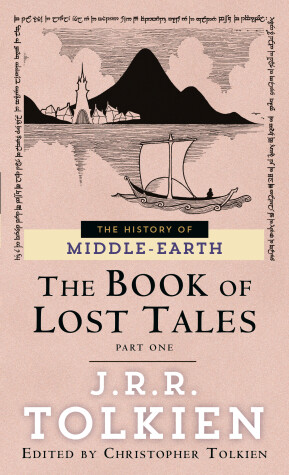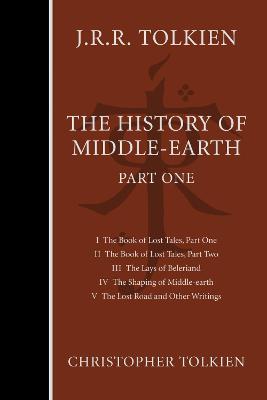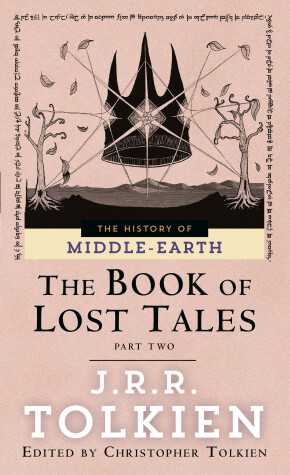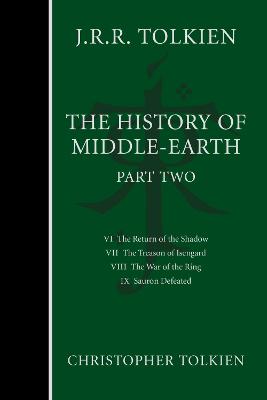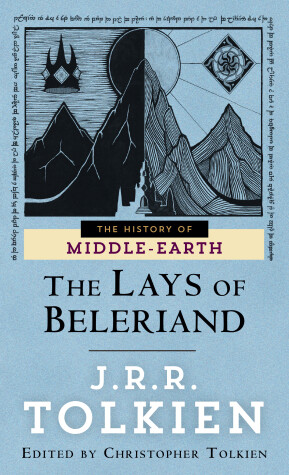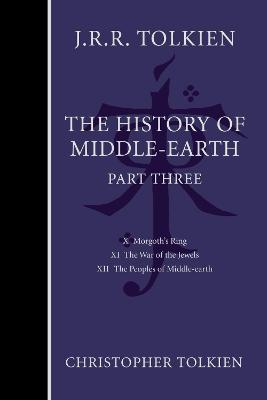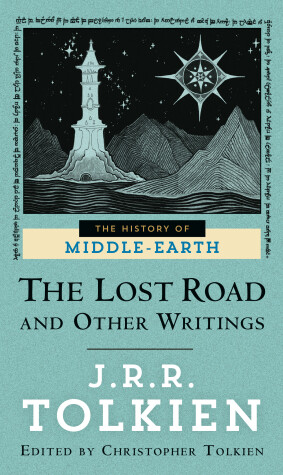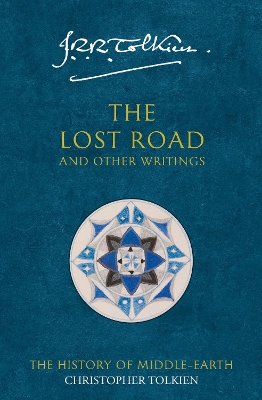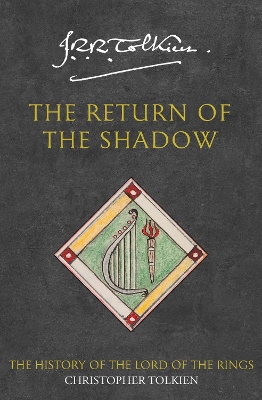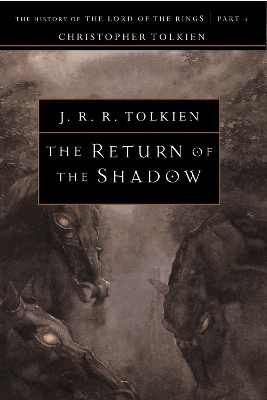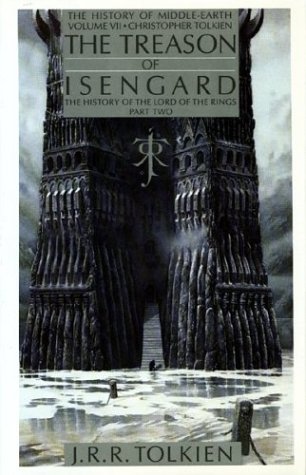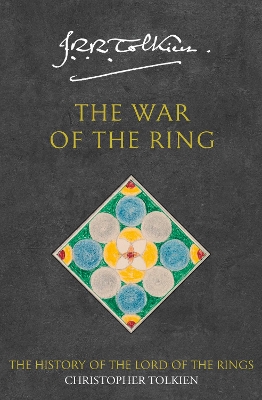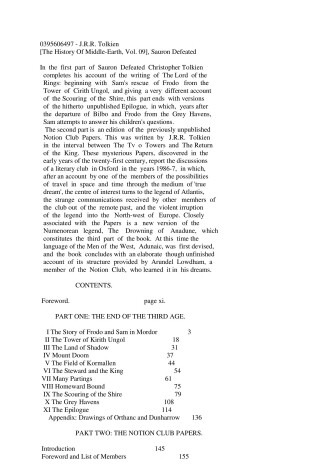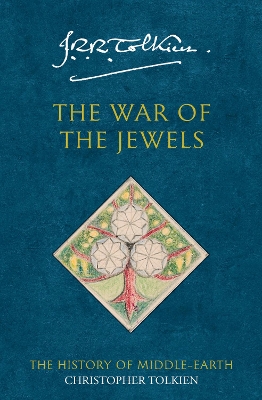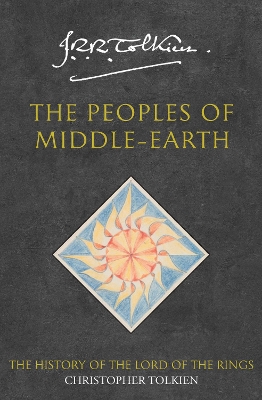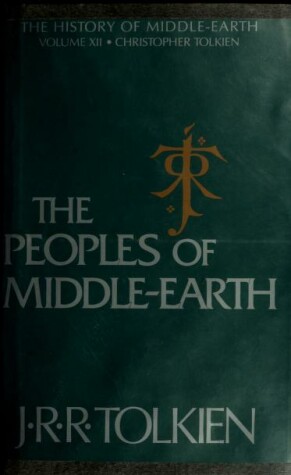The History of Middle-Earth
17 primary works • 26 total works
Book 1
The Book of Lost Tales stands at the beginning of the entire conception of Middle-earth and Valinor. Embedded in English legend and English association, they were set in the narrative frame of a great westward voyage over the Ocean by a mariner named Eriol (or Ælfwine) to Tol Eressëa, the Lonely Isle, where Elves dwelt; from them he learned their true history, the Lost Tales of Elfinesse. In the Tales are found the earliest accounts and original ideas of Gods and Elves; Dwarves and Orcs; the Silmarils and the Two Trees of Valinor; Nargothrond and Gondolin; and the geography and cosmology of the invented world.
Praise for Book of Lost Tales 1
“In these tales we have the scholar joyously gamboling in the thickets of his imagination. . . . A commentary and notes greatly enrich the quest.”—The Daily Telegraph
“Affords us an almost over-the-shoulder view into the evolving creative process and genius of J.R.R. Tolkien in a new, exciting aspect . . .The superb, sensitive, and extremely helpful commentary and editing done by Christopher Tolkien make all of this possible.”—Mythlore
Book 1
The History of Middle-Earth, Part One
by Christopher Tolkien and J. R. R. Tolkien
Book 2
This fascinating second part of The Book of Lost Tales features the tales of Beren and Lúthien, Túrin and the Dragon, and the only full narratives of the Necklace of the Dwarves and the Fall of Gondolin. Essential reading for Middle-earth aficionados, each tale is followed by commentary from editor Christopher Tolkien. Also included is extensive information on the names and vocabulary in the earliest Elvish languages.
“The Tales will be appreciated by those who have read The Silmarillion and wish to examine how Tolkien improved his story and style from their original form, and how eventually The Lord of the Rings came to stand independently with only a few hints from the early mythology.”—British Book News
Book 2
The History of Middle-Earth, Part Two
by Christopher Tolkien and J. R. R. Tolkien
Book 3
“The power of Tolkien’s central characters—tragic, cursed Túrin; the lovers Beren and Lúthien—shines through.”—Library Journal
Gathering together two of the most crucial stories in Tolkien’s world—those of Túrin, a hero living under a ruinous family curse, and Lúthien, an elven princess whose love for a mortal man is mirrored ages later in Arwen and Aragorn—The Lays of Beleriand sheds light on the creation of the mythology of Middle-earth.
Journey through darkness with Túrin Turambar as he searches for his long-missing father in The Lay of the Children of Húrin, and join Beren and Lúthien on their quest to cut a Silmaril from Morgoth’s crown in The Lay of Leithian. Both narratives appear here in alliterative verse and are accompanied by Christopher Tolkien’s commentary on the evolution of the history of the Elder Days. Also included is critical analysis by C. S. Lewis of The Lay of Leithian.
Book 3
The History of Middle-Earth, Part Three
by Christopher Tolkien and J. R. R. Tolkien
Book 4
This fourth volume of The History of Middle-earth presents early versions of those first tales, from the creation myth to the fall of Morgoth. Writings include a chronology of the events in Beleriand, the first Silmarillion map, and the only known description of the physical nature of Middle-earth's universe. Detailed annotations highlight changes ranging from the spelling of Elvish names to pivotal emendations whose effects reach even to the war of the ring.
The Shaping of Middle-earth presents a solid framework by which to trace the development of the early lore of Middle-earth. It is a truly indispensable reference work for those familiar with the history of that endlessly beloved land—and fascinating reading for those just entering that world.
Book 5
As friends and fellow members of the literary circle known as The Inklings, J. R. R. Tolkien and C. S. Lewis embarked on a challenge. Lewis was to write on “space-travel” and Tolkien on “time-travel.” Lewis’s novel Out of the Silent Planet became the first book of a science fiction trilogy. Tolkien’s unfinished story “The Lost Road” chronicles the original destruction of Númenor, a pivotal event of the Second Age of Middle-earth.
In this intriguing volume, Christopher Tolkien traces the vivid history of Middle-earth, bringing the land—its topography and ever-clashing forces—to the state readers recognize from The Lord of the Rings. Entertaining and informative, The Lost Road and Other Writings shares fresh insights into the evolution of one of the world’s most enduring fantasies.
Book 5
The fifth volume of the History of Middle-earth, containing the early myths and legends which led to the writing of Tolkien’s epic tale of war, The Silmarillion.
At the end of 1937, J R R Tolkien reluctantly set aside his work on the myths and heroic legends of Valinor and Middle-earth and began The Lord of the Rings.
This fifth volume of The History of Middle-earth completes the examination of his writing up to that time. Later forms of The Annals of Valinor and The Annals of Beleriand had been composed, The Silmarillion was nearing completion in a greatly amplified form, and a new Map had been made. The legend of the Downfall of Numenor had entered the work, including those central ideas: the World Made Round and the Straight Path into the vanished West. Closely associated with this was the abandoned ‘time-travel’ story The Lost Road, linking the world of Numenor and Middle-earth with the legends of many other times and peoples.
Also included in this volume is the The Lhammas, as essay on the complex languages and dialects of Middle-earth, and an ‘etymological dictionary’ containing an extensive account of Elvish vocabularies.
Book 6
The first part of The History of The Lord of the Rings, an enthralling account of the writing of the Book of the Century which contains many additional scenes and includes the unpublished Epilogue in its entirety.
The Return of the Shadow is the story of the first part of the history of the creation of The Lord of the Rings, a fascinating study of Tolkien’s great masterpiece, from its inception to the end of the first volume, The Fellowship of the Ring.
In The Return of the Shadow (the abandoned title of the first volume of The Lord of the Rings) we see how Bilbo’s magic ring evolved into the supremely dangerous Ruling Ring of the Dark Lord; and the precise, and astonishingly unforeseen, moment when a Black Rider first rode in to the Shire. The character of the hobbit called Trotter (afterwards Strider or Aragorn) is developed, and Frodo’s companions undergo many changes of name and personality.
The book comes complete with reproductions of the first maps and facsimile pages from the earliest manuscripts.
This series of fascinating books has now been repackaged to complement the distinctive and classic style of the ‘black cover’ A-format paperbacks of The Hobbit, The Lord of the Rings, The Silmarillion and Unfinished Tales.
Book 6
Book 7
The second part of The History of The Lord of the Rings, an enthralling account of the writing of the Book of the Century which contains many additional scenes and includes the unpublished Epilogue in its entirety.
The Treason of Isengard continues the account of the creation of The Lord of the Rings started in the earlier volume, The Return of the Shadow.
It races the great expansion of the tale into new lands and peoples south and east of the Misty Mountains: the emerence of Lothlorien, of Ents, of the Riders of Rohan, and of Saruman the White in the fortress of Isengard.
In brief outlines and pencilled drafts dashed down on scraps of paper are seen the first entry of Galadriel, the earliest ideas of the history of Gondor, and the original meeting of Aragorn and Eowyn, its significance destined to be wholly transformed.
The book also contains a full account of the original map which was to be the basis of the emerging geography of Middle-earth.
This series of fascinating books has now been repackaged to complement the distinctive and classic style of the 'black cover' A-format paperbacks of The Hobbit, The Lord of the Rings, The Silmarillion and Unfinished Tales.
Book 8
The third part of The History of The Lord of the Rings, an enthralling account of the writing of the Book of the Century which contains many additional scenes and includes the unpublished Epilogue in its entirety.
The War of the Ring takes up the story of The Lord of the Rings with the Battle of Helm’s Deep and the drowning of Isengard by the Ents, continues with the journey of Frodo, Sam and Gollum to the Pass of Cirith Ungol, describes the war in Gondor, and ends with the parley between Gandalf and the ambassador of the Dark Lord before the Black Gate of Mordor.
The book is illustrated with plans and drawings of the changing conceptions of Orthanc, Dunharrow, Minas Tirith and the tunnels of Shelob’s Lair.
Book 9
Book 10
Book 11
The second of two companion volumes which documents the later writing of The Silmarillion, Tolkien’s epic tale of war.
In The War of the Jewels Christopher Tolkien takes up his account of the later history of The Silmarillion from the point where it was left in Morgoth’s Ring. The story now returns to Middle-earth, and the ruinous conflict of the High Elves and the Men who were their allies with the power of the Dark Lord. With the publication in this book all of J.R.R. Tolkien’s later narrative writing concerned with the last centuries of the First Age, the long history of The Silmarillion, from its beginning in The Book of Lost Tales, is completed; and the enigmatic state of the work at his death can be understood.
This book contains the full text of the Grey Annals, the primary record of The War of the Jewels, and a major story of Middle-earth now published for the first time: the tale of the disaster that overtook the forest people of Brethil when Hurin the Steadfast came among them after his release from long years of captivity in Angband, the fortress of Morgoth.
Book 12
The Peoples of Middle-earth traces the evolution of the Appendices to The Lord of The Rings, which provide a comprehensive historical structure of the Second and Third Ages, including Calendars, Hobbit genealogies and the Westron language. The book concludes with two unique abandoned stories: The New Shadow, set in Gondor during the Fourth Age, and the tale of Tal-elmar, in which the coming of the dreaded Numenorean ships is seen through the eyes of men of Middle-earth in the Dark Years.
With the publication of this book, the long history of J.R.R. Tolkien’s creation is completed and the enigmatic state of his work can be understood.
v. 6
v. 12
v. 11
